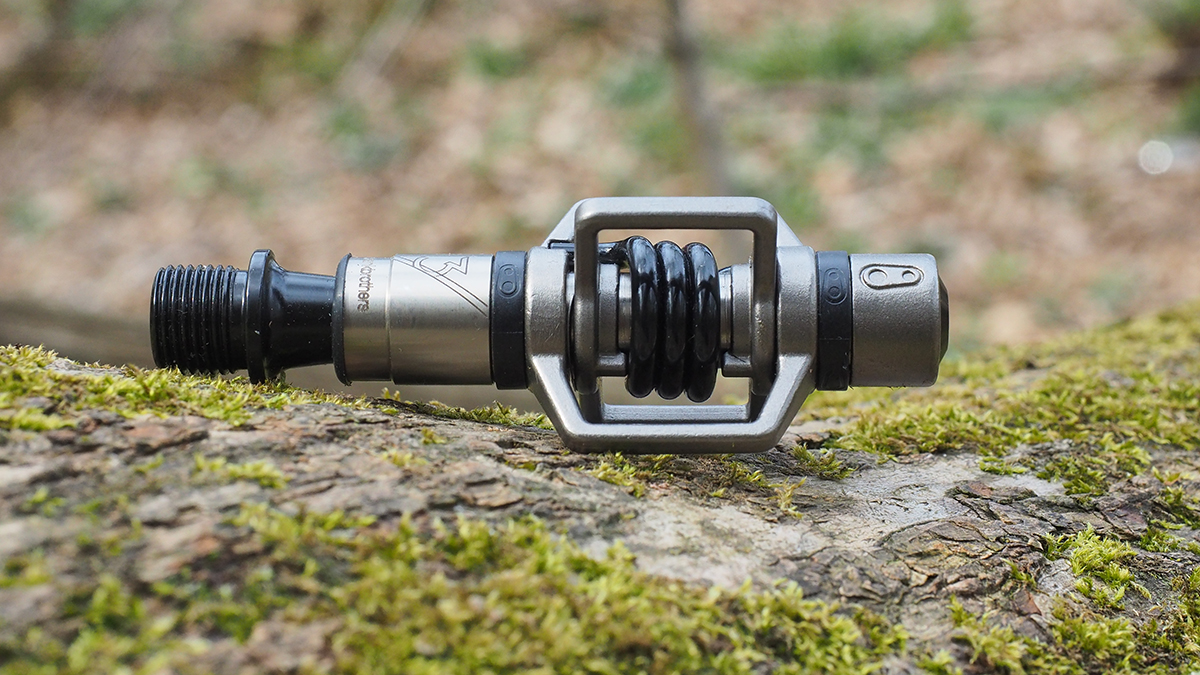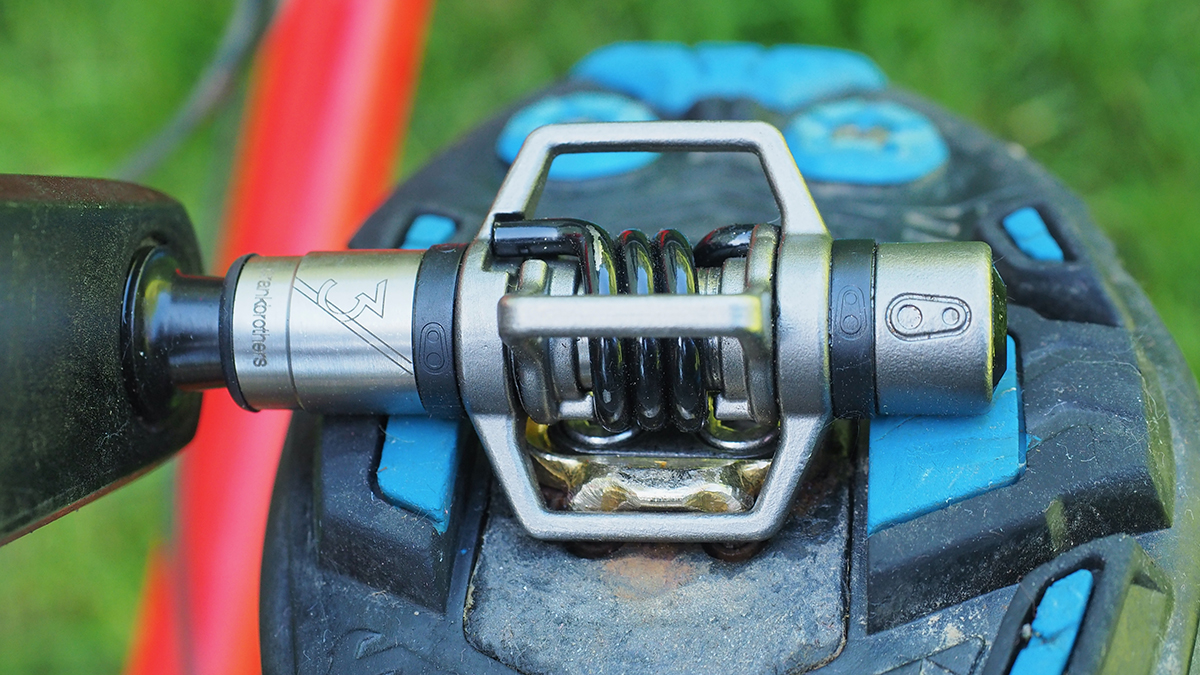Bike Perfect Verdict
A deceptively stable design and the ability to fine-tune your cleats make the Eggbeaters an appealing prospect, if you can get over the psychology of the clip-out.
Pros
- +
Great in mud
- +
Light
- +
5-year guarantee
- +
Low maintenance and easily repairable
- +
Float and release angle options
Cons
- -
Vaguer clip-out than SPDs
- -
No tension adjustment
- -
Not so good for soft shoes
- -
Less support for movement than a platformed pedal
- -
(Deliberately) softer cleats
Why trust BikePerfect
It’s hard to believe Eggbeater pedals are now over 20 years old – they still look like a wild clipless pedal experiment that could never catch on. But catch on they did, with a fanbase among weight weenies, mud pluggers, and cyclocross racers in particular.
In their earlier years, they didn’t have the greatest reputation for reliability, particularly for their internal components, but in 2016 new management at Crankbrothers pulled their fingers out, upgraded the axles, bearings, and seals, and slapped a five-year guarantee on all but the entry-level models, to put its money where its mouth was.
For information on Bike Perfect's testing procedures and how our scoring system works, see our how we test page.
As well as a distinctive look and colour options, Eggbeaters have a distinctive feel, and adjustability via a range of cleats. Read on and find out if they might be right for you.

Design and aesthetics
They do look like a pair of kind of cool broken pedals, which is no surprise since everything on the outside of the pedal except the axle housing, tension springs, and cleat rails (or ‘wings’) has been disposed of. If the question was ‘how little can we leave’, the answer was ‘the bit that balances your foot on the pedal’ and ‘the bit that holds you in’.
That wasn’t the actual question, as it turns out, though the answer was the same. The Crank Brothers (Carl and Frank) were trying to solve the problem of mud-clogged pedals making clip-in impossible. Since mud typically gets compacted between the clip and the pedal platform, they ditched the platform.
The design they settled on had the bonus of letting you clip in from any of the four faces of the pedal.
One fundamental difference on all Crankbrothers pedals compared with Shimano’s SPD design is that the springs are only used as you clip in and out – they don’t hold your foot into the cleat. The pressure of the cleat against the spring forces the bars apart momentarily, and once you’re in, it’s the snug fit between the bars, the cleat and the pedal body that keeps your shoe solid.
That keeps things simple, but along with the fact that there’s no tension adjustment for clipping in and out, it means all your tweakability comes down to your choice of cleat, which just governs float and release angle – more on that below.
Like their sibling pedals, Eggbeaters have a bit more pizazz than most – they come with either electric blue, red or black springs and seal edges.

Specifications
There are four versions of the Eggbeater: 1,2,3 and a Spinal Tap-esque level 11.
The main differences between the $60/£57 Eggbeater 1, the $100/£90 Eggbeater 2 and the $140/£130 Eggbeater 3 are in quality, rather than weight. The 3 gets forged wings rather than stamped ones, better quality bearings, and the 2 and 3 have five-year guarantees rather than two years.
The 1,2, and 3 all weigh in at around 280g per pair (my 3 weighed 286g), which puts the 312g of Shimano’s top-tier XTR 9100 pedal into perspective. The titanium Eggbeater 11 is an insane 180g per pair, but that will cost you an equally insane $450/£400.
The outer bearings on the Eggbeater 3 are Enduro MAX cartridge bearings. The inner bearings are a ‘plain bearing’. I had to look this up – it’s basically a sophisticated plastic sleeve on a plastic spindle layer, which has lubricating microparticles within the material. That gives constant lubrication across both surfaces of the bearing, even though technically it’s running dry. To you and me, it’s a long-lasting, no-maintenance bearing with a big surface area. There’s also a double seal system to keep the muck out.
Fit is important – your shoe needs to rest on the body of the pedal rather than the cleat mechanism, for stability and trouble-free clip-out.
Like SPDs, Eggbeaters come with 1mm shims in case the cleat recess of your shoes is too deep.
The Eggbeater 3s also come with spacers you can add to the pedal spindle in case the recess is too shallow, which could particularly be the case if your shoes wear down and would cause the shoe to rattle on the pedal. As it was, my selection of Giro and Shimano shoes and boots sat just fine with the Eggbeaters, as they do with SPDs.
Finally, you get more options for float (natural foot rotation while you ride) and release angle (the point at which it actually disengages) than you do with SPDs. More on this below.
Performance
The main surprise with Eggbeaters is that they look as if they should be unstable but they're not. The sole of the shoe rests squarely on the body of the pedal on either side of the cleat, so as you pedal there’s no rocking and you feel all your power is going where it should.
Clip-in is super-easy, so if you tend to fluff race starts with SPDs, the four sides of engagement are your friend here. And mud performance is indeed excellent, even in the horrible grit and mud combinations that blight hopping on and off in some cyclocross races.
Because stack height – the vertical distance from the center of the axle to where your shoe rests on the body – is in between an XT and an XTR pedal at a svelte 8.4mm, that makes you feel more planted on the pedal. Combined with the barely-there horizontal profile, that makes rock strikes less likely, though arguably rock strikes could have higher consequences because the engagement mechanism is so exposed.

One negative of not having a platform is that there’s nothing to guide your foot onto the right position on the cleat. For me that was odd at first, but something that became more instinctive over time.
The other negative is that there’s less underfoot support if you like to shift around on your pedals while standing. This wasn’t an issue for me, but Crankbrothers says that even half the xc racers who use its pedals would choose the small-platformed Candy pedals over the Eggbeater for that reason. You might also appreciate a little extra platform if you use softer shoes.
Probably the most divisive thing about the Crankbrothers pedals, for those coming from SPDs anyway, is the smooth clip-out, compared with the definite resistance and clunk of an SPD. I suspect this is more of a psychological problem than a practical one. I confess I haven’t got used to it yet, but I’ve never accidentally clipped out, and clubmates who ride Crankbrothers pedals wouldn’t even notice it.
Swapping to zero-float cleats may give a little more familiarity for SPD users, if your biomechanics allow it. I don’t know if that’s because SPDs have less float than the default Crankbrothers cleats (4 degrees vs 6), or because with zero float you know that as soon as you twist your heel you’re on your way towards clipping out, or a bit of both, but either way, they were the cleats I settled on.
(You can also change the release angle from 15 to 20 degrees by swapping the default cleats from one shoe to the other. And you can buy ‘easy release’ variants that have a 10-degree release angle. The smaller the release angle, the sooner your foot disengages as you turn your heel outwards.)
Verdict
I’ve been pleasantly surprised by the Eggbeater 3s, and I’ll definitely keep using them for mud, cyclocross, and lightweight xc race day - and to try to get to the bottom of the psychological clip-out question over the year ahead.
If you just wanted to give them a tentative try you might be better off with the good-value Eggbeater 1, as the more resilient Eggbeater 3 is almost touching XTR pricing, and you’ll need to factor in the fact that the brass cleats will wear out more quickly than SPD cleats and are a little more expensive, at $27/£25 vs $20/£18. (The use of brass is deliberate, to reduce wear to the pedal itself.)
Tech Specs: Crankbrothers Eggbeater 3 pedals
- Price: $140/£130
- Colors: Electric blue, red, black
- Weight: 286g
- Key materials: Stainless steel body, wing and spring, chromoly steel spindle, brass cleats, plastic optional shims, and traction pads

Sean has old school cycle touring in his blood, with a coast to coast USA ride and a number of month-long European tours in his very relaxed palmares. Also an enthusiastic midpack club cyclocross and XC racer, he loves his role as a junior cycle coach on the Kent/Sussex borders, and likes to squeeze in a one-day unsupported 100-miler on the South Downs Way at least once a year. Triathlon and adventure racing fit into his meandering cycling past, as does clattering around the Peak District on a rigid Stumpjumper back in the day.
Height: 173cm
Weight: 65kg
Rides: Specialized Chisel Comp; Canyon Inflite CF SLX; Canyon Aeroad; Roberts custom road bike

